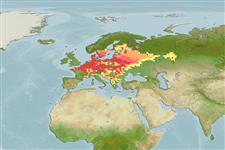Classification / Names
Common names from other countries
Main reference
Size / Weight / Age
Max length : 30.0 cm TL male/unsexed; (Ref. 556); 30.7 cm TL (female); common length : 15.0 cm TL male/unsexed; (Ref. 556)
Length at first maturity
Lm ?, range 11 - ? cm
Environment
Freshwater; brackish; demersal; potamodromous (Ref. 51243)
Climate / Range
Temperate; 4°C - 25°C (Ref. 1672), preferred ?; 62°N - 42°N, 15°E - 61°E
Distribution
Europe and Asia: In Europe, north of the Alps, from Meuse eastward to Neva drainages and Lake Ladoga; northern Black Sea basin from Danube eastward to Kuban, absent on the southern section; Caspian basin in Volga and Ural drainages. Not native to Great Britain, Scandinavia, Apennine and Iberian peninsulas, Crimea, and Adriatic, Aegean and White Sea basins. Locally introduced in Rhône drainage (France) and perhaps elsewhere (Ref. 59043).
In Appendix III of the Bern Convention (protected fauna) (Ref. 1441).
Countries | FAO areas | Ecosystems | Occurrences | Introductions
Short description
IUCN Red List Status (Ref. 115185)
Threat to humans
Harmless
Human uses
Fisheries: of no interest; bait: usually
More information
ReferencesAquacultureAquaculture profileStrainsGeneticsAllele frequenciesHeritabilityDiseasesProcessingMass conversion
Tools
Special reports
Download XML
Internet sources
Estimates of some properties based on models
Phylogenetic diversity index
PD50 = 0.5039 many relatives (e.g. carps) 0.5 - 2.0 few relatives (e.g. lungfishes)
Trophic Level
3.4 ±0.45 se; Based on food items.
Resilience
Medium, minimum population doubling time 1.4 - 4.4 years (tm=2; Fec=100,000-150,000)
Vulnerability
Low to moderate vulnerability (31 of 100)
Price category
